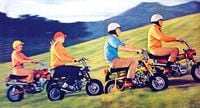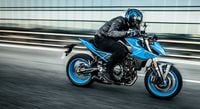Countless people got their first taste of two-wheeled freedom on a Honda minibike. Did you? Email your story to mcmail@bonniercorp.com.
Elsewhere in this issue you'll find Zack Courts' First Ride report on the new Honda Grom, an adorably awkward, street-legal playbike that exists somewhere near the intersection of BMX bike, full-size motorcycle, and bus pass. With stylized bodywork, a gold-anodized USD fork, and high-tech disc brake, it certainly looks modern. But the ungainly architecture imposed by small, fat tires and the distinct silhouette of that horizontally oriented, single-cylinder engine inextricably connect the Grom—SoCal slang for a young surfer—to Honda's long, successful legacy of minibikes from the '60s and '70s. One thing Honda excelled at during the '60s was making motorcycling fun and attractive to non-riders—those "nicest people" who previously never imagined themselves as motorcyclists. One way Red did this was building an almost endless series of quirky minibikes that looked and sounded nothing like big, backfiring, oil-spewing Harley-Davidsons their local Hells Angel preferred. They were bikes just like the Grom, in other words, with tiny frames, chubby tires, docile four-stroke singles, and automatic (or semi-automatic) transmissions that literally anyone could operate. "If you can put one foot in front of the other," read one period ad, "you can ride them."
Honda's first minibike, the Z100, was launched in 1961. Built on a rigid loop frame with 5-inch wheels and a 50cc engine, it was originally intended for Japanese amusement parks and quickly earned the nickname "monkey bike," a reference to how a grown adult looked sitting on the saddle. The Z50 Mini Trail—the bike that introduced thousands and thousands of Americans to two-wheeled travel—appeared in late 1968 alongside the CB750 superbike. The pint-sized Z50, top speed 25 mph, was yin to the CB750's yang, and even more successful. Honda sold more than 70,000 Z50s that first year, and it went on to become one of Honda's most long-lived models, remaining in production through 1999 (when it was succeeded by the equally successful XR50R).
Honda rapidly expanded its lineup to include larger, more capable minibikes. The stalwart, SOHC, two-valve, air-cooled single expanded to 70cc to power the hugely popular Trail 70, with its iconic pressed-steel T-frame, front and rear suspension, and folding handlebars that allowed the bike to stow away in a car trunk, RV bumper, or under the deck of a sailboat. Even more successful was the Trail 90, which plugged a 90cc version of the little-engine-that-could into a larger, step-through frame hung with 17-inch wheels, creating a proto-ATV that was hugely popular with hunters, fishermen, and other outdoor enthusiasts. You didn't get anywhere fast, but you had lots of fun and anyone could do it.
If you count up all the many variations, Honda made tens of millions of these fun-focused minibikes, introducing countless everyday people to the joys of single-track travel. Given Honda's laser-focus lately on luring non-riders into the two-wheeled fold with ever more user-friendly machines, it was almost inevitable that we see the return of fun, practical, stylish minibikes. After all, what grom—or what grom's mom—wouldn't rather bop along on two 12-inch tires than stand around and wait for the next Number 15 bus to come along?

/cloudfront-us-east-1.images.arcpublishing.com/octane/SG2E67BTUJHETN3FKBRMCDS3CQ.jpg)
/cloudfront-us-east-1.images.arcpublishing.com/octane/6DC3QAJSPJEQZF7KXNBOFGZX64.jpg)
/cloudfront-us-east-1.images.arcpublishing.com/octane/T2WRHM2RYVENHKM4TJKPGJHQZM.jpg)
/cloudfront-us-east-1.images.arcpublishing.com/octane/Y3L3XK4D5NHANIPLASAFHE4FAY.jpg)
/cloudfront-us-east-1.images.arcpublishing.com/octane/RP2FUYOZ4JDGRC666UKCWDLWPE.jpg)
/cloudfront-us-east-1.images.arcpublishing.com/octane/HT5PNEQC7VDXZHNYECPSKSYGTU.jpg)
/cloudfront-us-east-1.images.arcpublishing.com/octane/VN63PLIOMJCDJC3PWLIJQI5YHQ.jpg)
/cloudfront-us-east-1.images.arcpublishing.com/octane/SYIS3UGL7BGB5NEN5GSIVSFISM.jpg)
/cloudfront-us-east-1.images.arcpublishing.com/octane/H2NJJMCBSZCVHNDOGUQILJFMX4.jpg)
/cloudfront-us-east-1.images.arcpublishing.com/octane/K25WVPRMCVEDZJ7ZJK4BWE374Y.jpg)
/cloudfront-us-east-1.images.arcpublishing.com/octane/TQQGTGULURF5TOSK4FHQX7QKWY.jpg)

/cloudfront-us-east-1.images.arcpublishing.com/octane/THZ26BIH45AYBHU6WB527JTTCU.jpg)
/cloudfront-us-east-1.images.arcpublishing.com/octane/7OWQWAWJBFCGTAYQWBMWGNMNB4.jpg)
/cloudfront-us-east-1.images.arcpublishing.com/octane/4G5XKCDIHRCGRHVF7OPORG7ZX4.jpg)
/cloudfront-us-east-1.images.arcpublishing.com/octane/D2BDYKKNZ5GRHGDMI4PZTGRMME.jpg)

/cloudfront-us-east-1.images.arcpublishing.com/octane/UAY4WSZPOFDQRP4MCEXAKDFQOQ.jpg)

/cloudfront-us-east-1.images.arcpublishing.com/octane/X5CE3KSJHZHM5CUFGPZ7U26WB4.jpg)
/cloudfront-us-east-1.images.arcpublishing.com/octane/COWLTPGFAFGDDGJCTENYMA4VJM.jpg)
/cloudfront-us-east-1.images.arcpublishing.com/octane/H3PKUGPSUJFTND4RFPSI4OIDCE.jpg)
/cloudfront-us-east-1.images.arcpublishing.com/octane/UHGQA3MQDFCA3HLBWF7S76WH6Y.jpg)
/cloudfront-us-east-1.images.arcpublishing.com/octane/Q5EORCSTNFAVBJC4IYUHIKJTXQ.jpg)